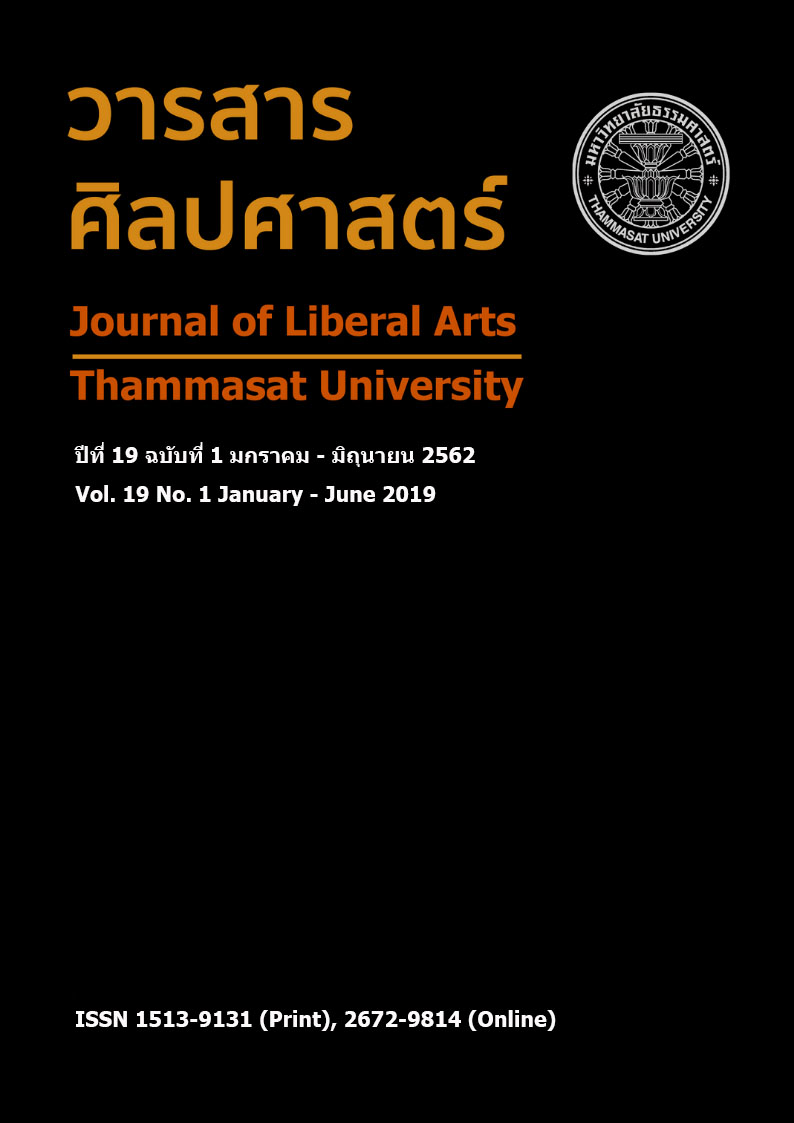Effects of Integrating Literature Circles and Guided Reciprocal Peer Questioning on Students’ Reflective Writing and Intellectual Content in the Discussion
Main Article Content
บทคัดย่อ
This research project investigated the effects of using Literature Circles and Guided Reciprocal Peer Questioning on students’ writing and discussion. The study focused on the reflective components of students’ writing assignments, the intellectual content of their literary discussions and explored students’ views concerning the benefits of this activity. A framework by Pasternak and Rigoni (2015) was used to evaluate students’ reflective writings and a framework from Marshall (1995) was used to analyze the intellectual content in discussion. It was found that students were able to produce Analytical Reflections and Descriptive Writings with high frequency. In addition, students performed well in the categories of Inform-interpret, Inform-evaluate and Response in their discussion abilities.
Downloads
Article Details
เอกสารอ้างอิง
Barone, D., & Barone, R. (2012). Building Background Knowledge within Literature Circles. Voices from The Middle, 20(1), 10-15.
Bernadowski, C. (2013). Improving the Reading Attitudes of College Students: Using Literature Circles to Learn about Content Reading. Journal On English Language Teaching, 3(3), 16-24.
Boas, E. (2012). Using Literature Circles to Inquire into the Big Themes: Exploring the Refugee Experience. English in Australia, 47(3), 25-28.
Choi, I, Land, S.M., & Turgeon, A.J. (2005). Scaffolding peer-questioning strategies to facilitate metacognition during online small group discussion. Instructional Science, 33(5-6), 483-511.
Daniels, H. (2006). What’s the next big thing with literature circles. Voices from the Middle, 13(4), 10-15.
DeWitt, K., Pratt-Fartro, T., & Pinkie, E. (2014). Literature Circles Gone Upside Down. Reading In Virginia, 361.
Elhess, M., & Egbert, J. (2015). Literature Circles as Support for Language Development. English Teaching Forum, 53(3), 13-21.
Gelmini-Hornsby, G., Ainsworth, S., & O’Malley, C. (2011). Guided reciprocal questioning to support children’s collaborative storytelling. International Journal of Computer-Supported Collaborative Learning, 6(4), 577-600.
King, A. (1990). Enhancing peer interaction and learning in the classroom through reciprocal questioning. American Educational Research Journal, 27(4), 664-687.
King, A. (1991). Improving lecture comprehension: Effects of a metacognitive strategy. Applied Cognitive Psychology, 5(4), 331-346.
King, A. (1992). Comparison of self-questioning, summarizing, and notetaking-review as strategies for learning from lectures. American Educational Research Journal, 29(2), 303-323.
Vaghar, S., Abolfazl, et al. (2009). The effect of guided reciprocal peer questioning (GRPQ) on nursing students' critical thinking and metacognition skills. Iranian Journal of Medical Education, 8(2), 333-340.
Lock, Wai-ki. (2004). The effects of the guided reciprocal peer-questioning on the comprehension of social science subjects in secondary school (Master’s thesis, University of Hong Kong). Retrieved from http://dx.doi.org/10.5353/th_b3027760
Marshall, J. D. (1995). The Language of Interpretation: Patterns of Discourse in Discussions of Literature. Urbana: National Council of Teachers of English.
Monyanont, P. (2016). Using Literature Circles to Promote Reflective Writing Ability: A Perspective on the Co-operative Learning Approach. Humanity and Social Science Journal, Ubon Ratchthani University, 7(1), 128-146.
Pasternak, D. L., & Rigoni, K. K. (2015). Teaching reflective writing: thoughts on developing a reflective writing framework to support teacher candidates. Teaching/Writing: the journal of writing teacher education, 4(1), 5.
Sanacore, J. (2013). “Slow Down, You Move Too Fast”: Literature Circles as Reflective Practice. The Clearing House: A Journal of Educational Strategies, Issues and Ideas, 86(3), 116-120.
Shelton-Strong, S. J. (2012). Literature Circles in ELT. ELT Journal, 66(2), 214-223.
Skeen, C. G. (2014). Comparing Interactions in Literature Circles in Both Online and in Class Discussions. Texus: Sam Houston State University.
Smith, K., & Geil, A. (2016). Student Choice in Literature Circles in the Middle-School Classroom. Illinois Reading Council Journal, 44(3), 3-12.
Thein, A. H., Guise, M., & Sloan, D. L. (2011). Problematizing Literature Circles as Forums for Discussion of Multicultural and Political Texts. Journal of Adolescent & Adult Literacy, 55(1), 15-24. doi:10.1598/JAAL.55.1.2
Yahya, W. R. W, & Abd Rahim, N. (2009). Adult L2 Learning of Victorian Novels Using Literature Circles. International Journal of Learning, 16(1), 195-209.


